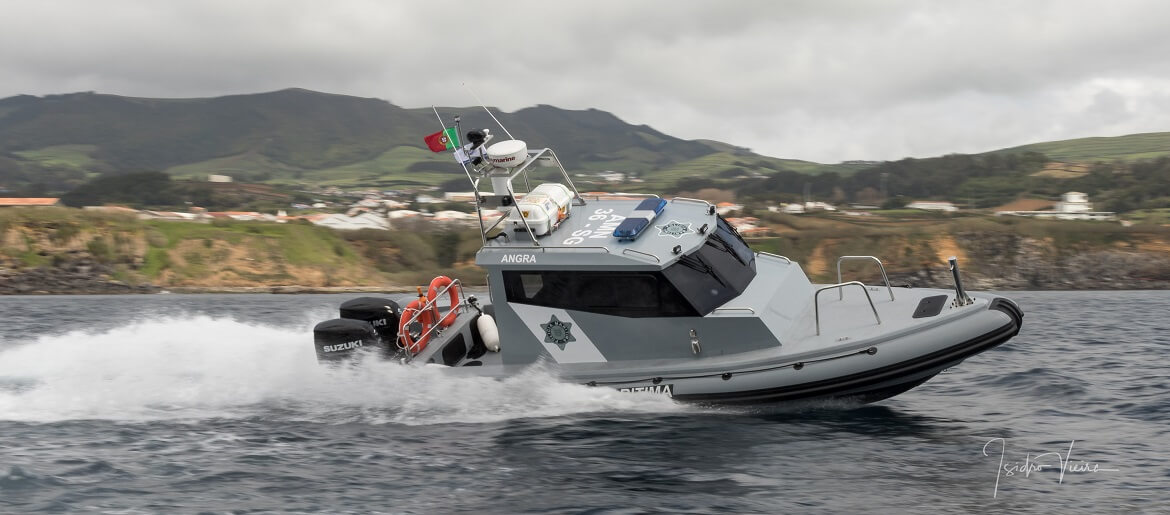On April 19, 2018, a ceremony for the delivery of three semi-rigid vessels with cabin (SRC) to the Regional Command of the Azores Maritime Police (CRPM of the Azores) was held in the city of Ponta Delgada on the island of S. Miguel, chaired by the Secretary State of National Defense and Maritime Affairs, Dr. Marcos Perestrello.
This construction project resulted from the need to equip the CRPM of the Azores with three fast SRC vessels, with autonomy and in conditions to prolong the operation with the shelter in a protection cabin, in adverse meteorological and oceanographic conditions in the Azores. The construction project was started in the first half of 2017 at the General Directorate of the Maritime Authority, until the signing of the construction contract with the shipyard Navalethes de Viana do Castelo, which occurred on July 31, 2017.
The three new nautical means SRC were assigned to the three Local Commands of the Maritime Police of Ponta Delgada, Angra do Herísmo and Horta, each of the vessels assuming the name of each destination city. After the delivery ceremony, SRC vessels Angra and Horta sailed from Ponta Delgada, by sea to each of their bases on Terceira Island and Faial Island.
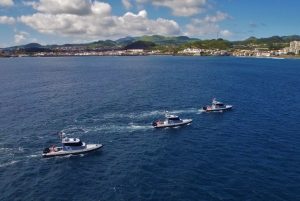
CONCEPT OF EMPLOYMENT
SRC vessels are nautical means intended to carry out operations related to the policing, control and supervision of maritime space under national sovereignty and jurisdiction and of economic activities within a radius of 100 nautical miles (185 km), prepared to operate under environmental conditions adverse and severe, as is the marine environment, in particular that of the Autonomous Region of the Azores.
The vessels are engaged in patrol, surveillance, surveillance, natural resource protection, maritime search and rescue operations and may also be engaged, depending on the nature of the operation, in missions to support cooperative and / or combined operations , in particular in the field of maritime safety:
Performance in states of exception;
Cooperation with security forces and services (FSS) in the face of transnational threats;
Surveillance and control, including maritime surveillance;
Maritime search and rescue;
Support for safeguarding people and property
PROJECT REQUIREMENTS
In the construction project of SRC vessels, the good nautical qualities were guaranteed, namely: high buoyancy, robustness, mobility, maneuverability, dynamic behavior at sea and, above all, excellent stability, even at large angles of transverse inclination.
In relation to the operation of these nautical devices, the need for a cabin with space for crew members to operate navigational and government equipment in different places (Pilot and navigator) was identified, with the addition of a total of four seats, fulfilling the vertical vibration damping requirements to which the crew members are subjected in navigations at sea at speeds exceeding 20 knots.
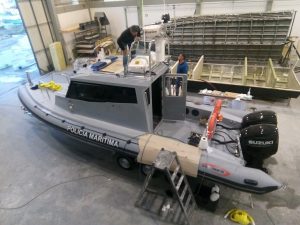
Another condition was to provide these nautical facilities with external engines, which would allow an autonomy of 200 nautical miles (370 km), thus conferring the capacity of SRC vessels based in Ponta Delgada, Angra do Heroísmo and Horta to move to any Island of Autonomous Region of the Azores within the limits of their autonomy and operate, within a radius of action of 100 nautical miles from their bases, without refueling.
CONSTRUCTION FEATURES
The structure of the SRC vessel under the Searibs-PATROL1000 brand, consists of three parts: the hull, rigid part built of polymer-reinforced fibers; the float, consisting of an inflatable tube of resistant material under the trade name Hypalon Neoprene; and a third part, the cabin, built in the same material as the hull.
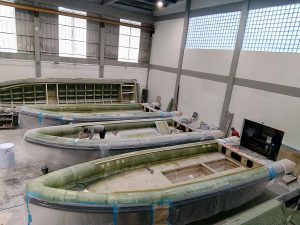
The hull is manufactured in glass fiber reinforced plastic (PRFV), with resistant elements (stringers and caves) in maritime plywood, duly dimensioned, in order to give the necessary robustness to the hull and the necessary protection to this type of construction (epoxy paint or Topcoat). The shape of the “V” hull from stem to stern, staggered with hydrodynamic rails in the longitudinal direction of the sails, allows to give a vertical thrust capacity to the hull, as its speed increases, improving its performance to glide even at low speeds.
The fully equipped stowage vessel is self-draining on the deck and in the well, aft of the cabin, for drainage of water remaining from the interior to the sea by the transom.
The superstructure of the cabin is an enclosed space, which serves to protect the crew in the operation of government and navigation, conserving an extra space aft of the four seats and another, for storage, ahead of the control console.

The deck floor ahead of the cabin is constructed of GRP sandwich, with the interior of high density PVC plastic foam, laminated on both sides, allowing these vessels, in adverse sea conditions, to enter the space without embarking water bow. The deck has an anti-slip finish and a small interior balustrade, which allow to make actions of approaches to other vessels or ships, without causing damage in the contact with the lashes or through.
It is possible to move personnel from rear to front of the cabin, on both sides, safely, with handles and handrails along the cabin and interior balustrade, for example maneuvering the iron or the mooring to the bow.
PROPULSION AND GOVERNMENT
The propulsion of these boats is composed by two external engines of brand Suzuki, gasoline with the cycle of 4 times, power of 250 horses (186 Kw) to 6,000 RPM (Rotations Per Minute), displacement of 4,169 cm3 with a disposition of 6 cylinders (60 Degrees), 24 valves per cylinder, double camshaft at the head of the engine and a multipoint fuel supply system controlled by an electronic management unit called EFI. In summary, the characteristics of the propulsion system give a very acceptable performance to the SRC, with speeds above 30 knots (about 56 km / h), presenting very balanced fuel consumption and a range of 200 nautical miles, at cruising speed of 25 knots (about 46 km / h).

In addition, engines comply with exhaust emission and noise limits as defined by Directive 2013/53 / EU of the European Parliament and of the Council of 20 November 2013.
The steering system is aided by an electro-hydraulic system, which allows maneuvering of the two outer motors very efficiently.
The SRC vessels are easy to maintain, thanks to the fact that the various equipment and equipments are highly reliable, with maintenance support and spare parts easy to purchase through the representative, both on the continent and in the Azores.
NAVIGATION AND SALVATION AID EQUIPMENT
The SRC vessels come equipped with a modern Raymarine-branded equipment, which integrates a 12-inch color screen with radar surface information, probe, GPS position, AIS information [1], nautical cartography information, statistics and navigation forecast , and allows to integrate information related to the fuel management system and monitoring of propulsion engines.

In the navigation aid, it also has a VHF communication equipment and position transmitter by AIS, via its MMSI address [2].
The SRC vessels are equipped with SOLAS [3] type A survival rafts, a SART transponder [4], and an EPIRB beacon radio [5].
GENERAL CHARACTERISTICS
SRC Craft: Searibs – Patrol 1000 ;
Overall length: 10 m;
Capacity: 10 people;
Crew: 2 people;
Maximum load: 1,000 kg;
Propulsion: 2 outside engines (Suzuki 250 Hp);
Fuel capacity: 800 liters;
Maximum speed: More than 30 knots;
Cruising speed: 25 knots;
Range of action: 100 nautical miles (185 Km);
Autonomy (Cruising speed): 200 nautical miles (370 Km) + 30% reserve.
FINAL CONSIDERATIONS
The availability of nautical means, which increases the effectiveness of these three SRC vessels in the service of the Local Commands of the Maritime Police of Ponta Delgada, Angra do Heroísmo and Horta represents, by the differentiated attributes in its design and operation, a non-abdicable value for the CRPM of the Azores, which wants to be deterrent, effective, efficient and efficient in the Autonomous Region of the Azores, which has in its maritime space an unalienable strategic and security asset.
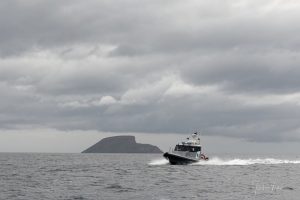
1] AIS: Automatic Information System , Automatic Identification Information System and Ship Type.
[2] MMSI: Mobilie Maritime Safety Identification, identification of mobile maritime safety using an international code number.
[3] SOLAS: Safety of Life At Sea , International Convention for the Safety of Life at Sea
[4] SART: Search And Rescue Transponder , is a radar radio signal response device, activated in emergency situations. It is conditioned to the radar range of ships sailing in the vicinity.
[5] EPIRB: Emergency Position Indicating Radio Beacons, are location transmitters used in emergencies, detected and reported by satellites (Example COSPAS-SARSAT). When activated in an emergency situation, this unit sends intermittent signals with information that enables its location independently and autonomously.
Original article can be found here








